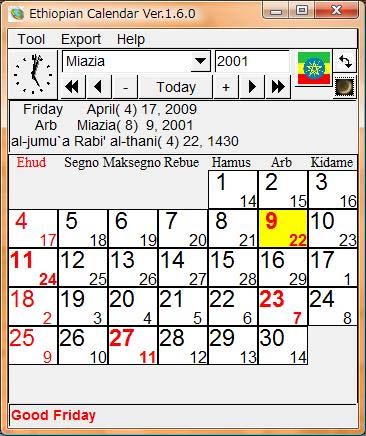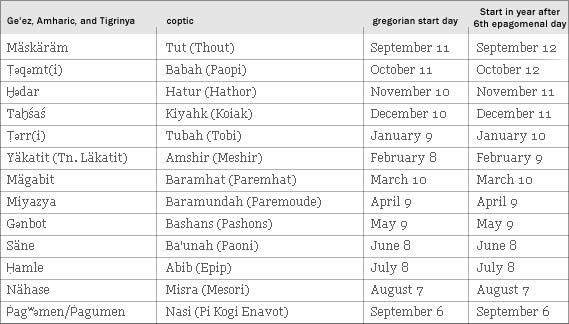The Ethiopian calendar, or Ge'ez calendar, is based on the older Alexandrian or Coptic calendar and is the principal calendar used in Ethiopia. It is also the liturgical year of Christians in Eritrea belonging to the Eritrean Orthodox Tewahdo Church, Eastern Catholic Church of Eritrea and Lutheran (Evangelical Church of Eritrea). Like the Julian calendar, it adds a leap day every four years without exception, and begins the year on August 29 or August 30 in the Julian calendar. There is a seven to eight year gap between the Ethiopian and Gregorian calendars, results from alternate calculations in determining the date of the Annunciation of Jesus.
The Ethiopian/Ge'ez calendar has twelve months of 30 days each plus five or six epagomenal days (usually called a thirteenth month). Furthermore, its months begin on the same days as those of the Coptic calendar, but they have different names, that are in Ge'ez. The sixth epagomenal day is added every four years without exception on August 29 in the Julian calendar, six months before the Julian leap day. So 1 Mäskäräm, the first day of the Ethiopian year, for years between 1901 and 2099 (inclusive), is usually the gregorian September 11, but falls on September 12 (Gregorian), in years before the Gregorian leap year. Contents
New Year in the Amharic, the official Ethiopia language. Eritrean Orthodox Tewahedo Church prefer to call it Ri'se Awde Amet (Head Anniversary) in Ge'ez. The new years begin on September 11 or 12 as described above from Gregorian 1900 to 2099, but differently in other Gregorian centuries, because every fourth Ethiopian/Ge'ez year is a leap year without exception.

Incarnation Era
To indicate the year, Ethiopians and followers of the Eritrean churches today use the Incarnation Era, which dates from the Annunciation or Incarnation of Jesus on 25 March 9 (Julian), as calculated by Annianus of Alexandria c. 400; thus its first civil year began seven months earlier on 29 August 8 (Julian). Meanwhile, Europeans eventually adopted the calculations made by Dionysius Exiguus in AD 525 instead, which placed the Annunciation exactly eight years earlier than had Annianus. This causes the Ethiopian year number to be eight years less than the Gregorian year number from January 1 until September 10 or 11, then seven years less for the remainder of the Gregorian year.
Era of Martyrs
The most important era – once widely used by the Eastern Churches, and still used by the Coptic Church - was the Era of Martyrs, also known as the Diocletian Era, whose first year began on 29 August 284.
Respectively to the western and Julian New Year's Days about three months later, the difference between the Era of Martyrs and the Anni Domini is 285 (= 15x19) years. This is because in AD 525, Dionysius Exiguus decided to add 15 Metonic cycles to the existing 13 Metonic cycles of the Diocletian Era (15x19 + 13x19 = 532) to obtain an entire 532-year medieval Easter cycle, whose first cycle ended with the year Era of Martyrs 247 (= 13x19) equal to year DXXXI. It is also because 532 is the product of the Metonic cycle of 19 years and the Solar cycle of 28 years.
Anno Mundi according to Panodoros
Around AD 400, an Alexandrine monk called Panodoros fixed the Alexandrian Era (Anno Mundi = in the year of the world), the date of creation, on 29 August 5493 BC. After the 6th century AD, the era was used by Egyptian and Ethiopian chronologists. The twelfth 532-year-cycle of this era began on 29 August 360 AD, and so 4x19 years after the Era of Martyrs.
Anno Mundi according to Anianos
Bishop Anianos preferred the Annunciation style as New Year's Day, the 25 March (see above). Thus he shifted the Panodoros era by about six months, to begin on 25 March 5492 BC.
The Leap year
The four year leap-year cycle is associated with the four Evangelists: the first year after an Ethiopian leap year is named in honour of John, followed by the Matthew-year and then the Mark-year. The year with the sixth epagomenal day is traditionally designated as the Luke-year. There are no exceptions to the four year leap-year cycle, unlike the Gregorian calendar.
Months

